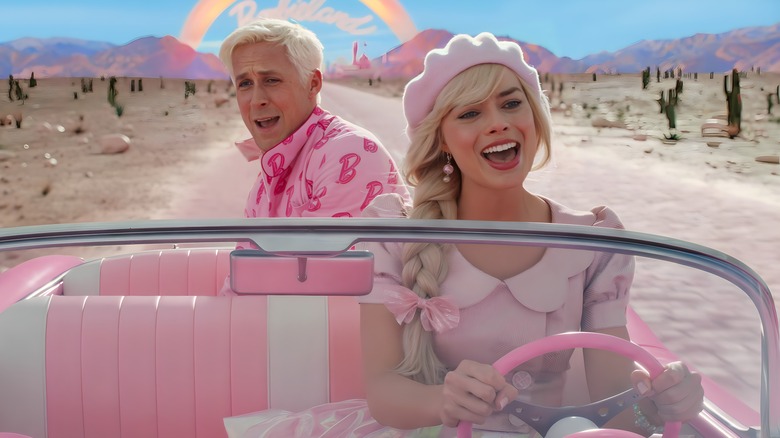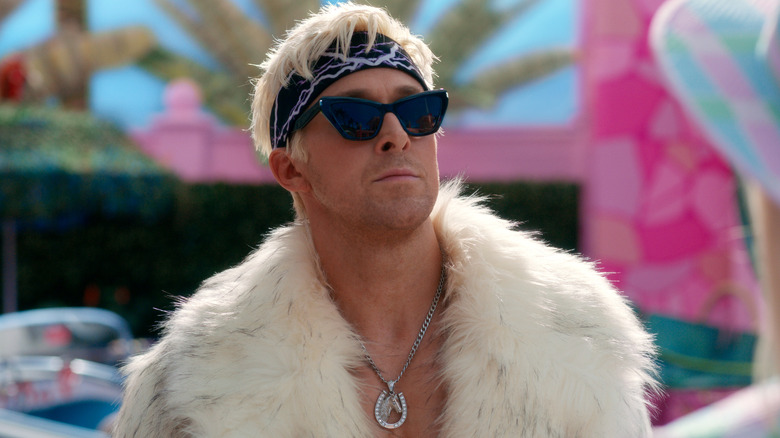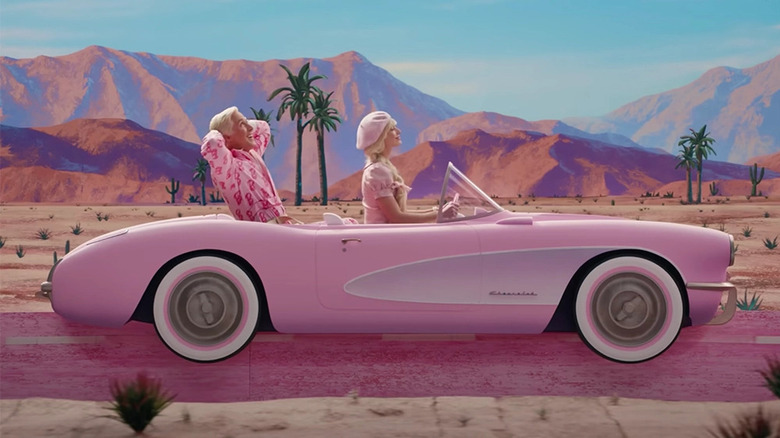Barbie: The Only Vehicle Not Inspired By A Real Toy Is More Crucial Than You Think
Greta Gerwig's "Barbie" movie is a love letter to Mattel's iconic toy line in so many ways, and that includes every aspect of the matriarchal, Pepto Bismol-pink Barbie Land. Gerwig and her team worked incredibly hard behind the scenes to create every aspect of the world, including Barbie's car, which Stereotypical Barbie (Margot Robbie) hops into and cruises around as the film begins. The pink and white car, styled after a Corvette, is definitely based on a real Barbie toy, as are Barbie's other travel implements like her snowmobile, camping van, and rocket ship. One vehicle, however, isn't based on a Barbie toy — and it's for an extremely specific reason.
When Barbie hops back into her car with her new friends Gloria (America Ferrera) and Sasha (Ariana Greenblatt) and returns to Barbie Land, she finds that Ken (Ryan Gosling) has transformed the entire place from top to bottom, dismantling the female-led society created by the Barbies and implementing a makeshift patriarchy. Ken's enormous Jeep sticks out like a sore thumb in pink Barbie Land, and it's supposed to; it's extraordinarily masculine, mirroring the big cars Ken saw — and liked — in the real world. Though Ken dolls can be paired with pink beach cruisers, they don't look anything like this big, manly Jeep.
Ken's version of patriarchy is pretty flawed
Did Ken technically bring the patriarchy to Barbie Land, a place established by Barbies and for Barbies? Technically, yes. Is his understanding of the patriarchy structurally sound? Sure isn't! During his sojourn to the real world alongside Barbie, Ken realizes that outside of Barbie Land, men are in charge of everything — and when he's not allowed to perform surgeries or score a high-paying job without any qualifications, he decides to go home and tell the other Kens what he's discovered. He does, and they create their own version of a patriarchy... although it's definitely a watered-down version of the very real patriarchy that exists.
Ken's version of the patriarchy involves stuff like that big Jeep, saloon doors, rechristening Barbie's Dream House as his "Mojo Dojo Casa House" (even though Gloria and Sasha correctly point out that saying "dojo," "casa," and "house" is redundant), and projecting videos of horses all over the place. He does subjugate and brainwash the Barbies along with the other Kens, but every single other aspect of his understanding of patriarchy is both bone-headed and benign; in one of the movie's funniest moments, he admits that once he realized patriarchy had very little (or nothing) to do with horses, he lost interest. If only the real-world version of the patriarchy was so poorly thought-out.
Barbie's car is designed with one specific detail in mind
Let's circle back to Barbie's pink Corvette, though — because it was created and sized in a very, very specific way. In an interview with the Motion Picture Association, Sarah Greenwood and Katie Spencer — the production designer and set decorator, respectively — revealed that the size of Barbie's car links back to the toy itself.
"If you put the doll in the Dreamhouse and she puts her hands in the air, she can touch the ceiling," Greenwood explained, saying that every single piece of the set was designed to scale strangely to a real human being. "She is strikingly out of scale. It's the same with the car. Barbie never quite fits because her legs don't bend. We worked it out to be 23% smaller than human size for the sets. What this did is when you built it for real, you made the actors seem bigger in the house. That gives it a toy quality or what we found out Mattel calls 'toyetic.' Finding what it is that makes it a toy."
The little details within "Barbie" really make the film sing, and clearly, Gerwig, Greenwood, and Spencer left no stone unturned and no car sized correctly. "Barbie" is in theaters now.


